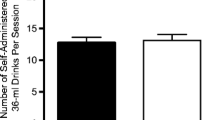Abstract
Thirty-two healthy subjects with histories of moderate caffeine consumption abstained from dietary caffeine throughout the study. Subjects were stratified into two groups based on several factors including caffeine preference, which was assessed using a caffeine versus placebo choice procedure. Subsequently, subjects received either caffeine (300 mg t.i.d.) or placebo (placebo t.i.d.) for 18 consecutive days, and thereafter were exposed again to a caffeine versus placebo choice procedure. The study documented tolerance development to the subjective effects of caffeine: after chronic dosing, administration of caffeine produced significant subjective effects in the chronic placebo group but not in the chronic caffeine group. The study also provided indirect evidence for tolerance development: during chronic dosing, the chronic caffeine and placebo groups did not differ meaningfully on ratings of mood and subjective effect. When subjects were categorized into caffeine choosers or nonchoosers, caffeine choosers tended to report positive subjective effects of caffeine and negative subjective effects of placebo. Nonchoosers, in contrast, tended to report negative subjective effects of caffeine. Chronic caffeine did not alter the reinforcing effects of caffeine as assessed by caffeine versus placebo choice, possibly because the relatively short duration of caffeine abstinence in the placebo condition was not sufficient to result in maximal withdrawal effects after termination of the relatively high caffeine dose. This study provides the clearest evidence to date of complete tolerance development to a CNS effect of caffeine in humans.
Similar content being viewed by others

References
Ammon HPT, Bieck PR, Mandalaz D, Verspohl EJ (1983) Adaptation of blood pressure to continuous heavy coffee drinking in young volunteers. A double-blind crossover study. Br J Clin Pharmacol 15:701–706
Barone JJ, Roberts H (1984) Human consumption of caffeine. In: Dews PB (ed) Caffeine: perspectives from recent research. Springer, Berlin Heidelberg New York, pp 59–73
Chait LD, Griffiths RR (1983) Effects of caffeine on cigarette smoking and subjective response. Clin Pharmacol Ther 34:612–622
Colton T, Gosselin RE, Smith RP (1968) The tolerance of coffee drinkers to caffeine. Clin Pharmacol Ther 9:31–39
Costa PT Jr, McCrae RR (1985) The NEO Personality Inventory Manual, Psychological Assessment Resources, Odessa, FL
Eddy NB, Downs AW (1928) Tolerance and cross-tolerance in the human subject to the diuretic effect of caffeine, theobromine and theophylline. J Pharmacol Exp Ther 33:167–174
Gilbert RM (1984) Caffeine consumption. In: Spiller GA (ed) The methylxanthine beverages and foods: chemistry, consumption, and health effects. Liss, New York, pp 185–213
Goldstein A (1964) Wakefulness caused by caffeine. Naunyn Schmiedeberg's Arch Exp Pathol Pharmakol 248:269–278
Goldstein A, Warren R, Kaizer S (1965) Psychotropic effects of caffeine in man. I. Individual differences in sensitivity to caffeine-induced wakefulness. J Pharmacol Exp Ther 149:156–159
Goldstein A, Kaizer S, Whitby O (1969) Psychotropic effects of caffeine in man. IV. Quantitative and qualitative differences associated with habituation to coffee. Clin Pharmacol Ther 10:489–497
Griffiths RR, Woodson PP (1988a) Caffeine physical dependence: studies in humans and laboratory animals. Psychopharmacology 94:437–451
Griffiths RR, Woodson PP (1988b) Caffeine reinforcement in humans. J Pharmacol Exp Ther 246:21–29
Griffiths RR, Woodson PP (1988c) Reinforcing properties of caffeine: studies in humans and laboratory animals. Pharmacol Biochem Behav 29:419–427
Griffiths RR, Bigelow GE, Liebson IA (1986a) Human coffee drinking: reinforcing and physical dependence producing effects of caffeine. J Pharmacol Exp Ther 239:416–425
Griffiths RR, Bigelow GE, Liebson IA, O'Keefe M, O'Leary D, Russ N (1986b) Human coffee drinking: manipulation of concentration and caffeine dose. J Exp Anal Behav 45:133–148
Griffiths RR, Evans SM, Heishman SJ, Preston KL, Sannerud CA, Wolf B, Woodson PP (1990) Low-dose caffeine physical dependence in humans. J Pharmacol Exp Ther 255:1123–1132
Haertzen CA (1974) An overview of Addiction Research Center Inventory Scales (ARCI): an appendix and manual of scales. US Government Printing Office, Washington, DC, pp 74–92
Hughes JR, Higgins ST, Bickel WK, Hunt WK, Fenwick JW, Gulliver SB, Mireault GC (1991) Caffeine self-administration, withdrawal and adverse effects among coffee drinkers. Arch Gen Psychiatry 48:611–617
Jacob P III, Wilson M, Benowitz NL (1981) Improved gas chromatographic method for the determination of nicotine and cotinine in biologic fluids. J Chromatogr 222:61–70
McNair DM, Lorr M, Droppleman LF (1971) EITS Manual for the Profile of Mood States, Educational and Industrial Testing Service, San Diego, CA
Robertson D, Wade D, Workman R, Woosley RL, Oates JA (1981) Tolerance to the humoral and hemodynamic effects of caffeine in man. J Clin Invest 67:1111–1117
Spielberger CD, Gorsuch RL, Lushene RE (1970) STAI Manual for the State-Trait Anxiety Inventory (“Self-Evaluation Questionnaire”), Consulting Psychologists Press, Palo Alto, CA
Spiller GA (1984) The chemical components of coffee. In: Spiller GA (ed) The methylxanthine beverages and foods: chemistry, consumption, and health effects. Liss, New York, pp 91–147
Stern KN, Chait LD, Johanson CE (1989) Reinforcing and subjective effects of caffeine in normal human volunteers. Psychopharmacology 98:81–88
van Dusseldorp M, Katan MB (1990) Headache caused by caffeine withdrawal among moderate coffee drinkers switched from ordinary to decaffeinated coffee: a 12 week double blind trial. BMJ 300:1558–1559
Weiss B, Laties VG (1962) Enhancement of human performance by caffeine and the amphetamines. Pharmacol Rev 14:1–36
Winsor AL, Strongin EI (1933) A study of the development of tolerance for caffeinated beverages. J Exp Psychol 16:725–744
Zwyghuizen-Doorenbos A, Roehrs TA, Lipschutz L, Timms V, Roth T (1990) Effects of caffeine on alertness. Psychopharmacology 100:36–39
Author information
Authors and Affiliations
Rights and permissions
About this article
Cite this article
Evans, S.M., Griffiths, R.R. Caffeine tolerance and choice in humans. Psychopharmacology 108, 51–59 (1992). https://doi.org/10.1007/BF02245285
Received:
Revised:
Issue Date:
DOI: https://doi.org/10.1007/BF02245285



